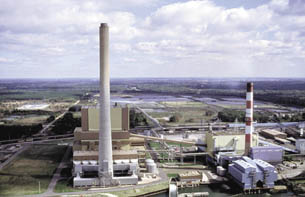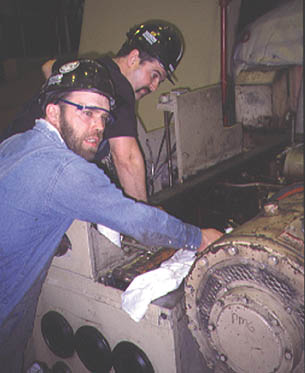Major Campbell outage will keep plant humming
Date Posted: April 14 2000
By Dennis McKee
More than 400 skilled tradesworkers teamed up with Consumers Energy's employees recently to tackle the biggest maintenance project in the utility's history. An intensive 70-day effort replaced more than 30,000 components of Unit 3 at the J.H. Campbell Generating Complex.
The $42 million maintenance outage will help keep Campbell 3 operating efficiently and reliably, especially during Michigan's hot summer months when customer demand for electricity soars.
Campbell 3 superintendent Gary Keller said the recently completed project wouldn't have been possible without the tradesworkers.
"During a normal outage, we can rely on our experienced maintenance and operations employees to get the work done," Keller said. "Frankly, there aren't enough hours in the day for our employees alone to complete this amount of work in a reasonable period of time, and some of the work really requires industry specialists."
Well-maintained power plants have never been more important to Michigan's families and businesses. Growing energy consumption has put heavy pressure on the electric grid. Transmission systems have capacity limitations that restrict the amount of electricity that Michigan can bring in from other states and Canada. Even though customers demand 2 percent to 4 percent more electricity each year, plans for more power plants are on hold until electric utility deregulation legislation is passed in Lansing.
Campbell 3 can produce up to 790 megawatts of electricity, enough for a community of about 600,000 people. The Campbell Complex, located between Holland and Grand Haven, has 320 employees and three units that generate up to 1,404 megawatts.
A mile-long train-load of coal is burned every day to heat millions of gallons of water to produce the steam necessary to turn a turbine and operate an electric generator. The electricity created at Campbell goes into Consumers Energy's electric transmission system to help meet the needs of the utility's 1.6 million electric customers statewide.
Keller said the tradesworkers and the Consumers Energy employees had to do a staggering amount of work in only 70 days.
"All told, the skilled trades contractors and our site employees replaced more than 30,000 components in our pollution abatement equipment, boiler, steam turbine and generator," he said. "We have never had a maintenance outage of this magnitude at any of the company's four coal-fired plant sites."
The general manager of the Campbell Complex, Bill Ritchie, emphasized that safety was never compromised, despite the deadline.
"We teamed our site safety coordinator with contractor counterparts to help prevent accidents and injuries. We held regular safety meetings for all workers and shared information about minor incidents that can be precursors to serious injuries. It was clear that we had good communication and safety teamwork - although we won't be completely successful during outages until we have zero safety incidents," said Ritchie.
The first installation of General Electric's new "dense pack" high-pressure turbine system was one of the many highlights of the project. With the breakthrough technology, Campbell 3 will be able to create more electricity from each pound of coal it uses. GE also worked with tradesworkers and Consumers Energy workers performing a rewind of the generator's copper cables.
Another highlight was the replacement of all 48 of the unit's coal burners. Those are injectors that shoot powdery pulverized coal into the plant's boiler in a process that is similar to how gasoline is shot into a carburetor. The new high technology burners will help lower Campbell 3's nitrogen oxide emissions to maintain compliance with the federal government's strict standards.
Age, federal Clean Air Act requirements, and timing came together to create the need for the project at Campbell 3, which began operating in 1980. While it took 20 years for Campbell 3 to need a maintenance outage of such magnitude, the record won't stand for long, Ritchie said.
"Periodic congressional amendments to the Clean Air Act require us to invest in new technology to meet stricter standards. The most recent round will require us to invest $300 million at Campbell over the next three years," Ritchie said. "That's about half of the book value of the whole site. We're in a tough business but it is among the most important enterprises in our economy, and I'm proud of our ability to make electricity in a manner that is safe, reliable, cost effective and respectful of the environment."
Consumers Energy, the principal subsidiary of the CMS Energy Corporation, is Michigan's largest utility providing natural gas and electricity to more than six million of the state's nine and one-half million residents in all 68 Lower Peninsula counties.

AN AERIAL VIEW of the J.H. Campbell Plant.

TRADESMEN Matt Martin and Steve Short work on a steam turbine at the J.H. Campbell Plant Unit 3.
